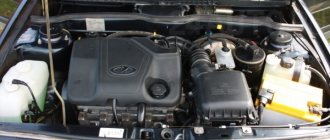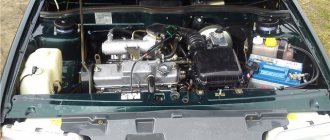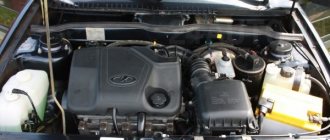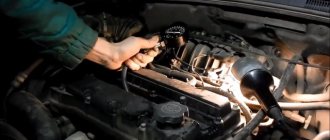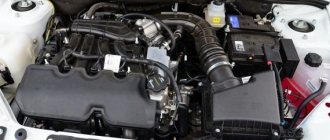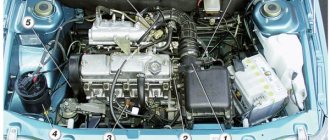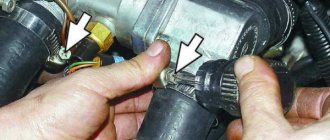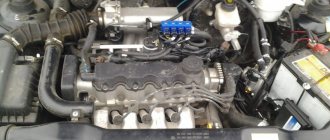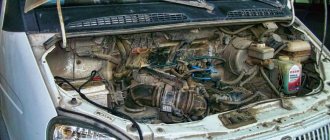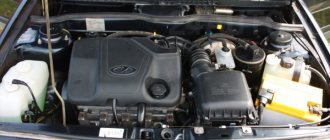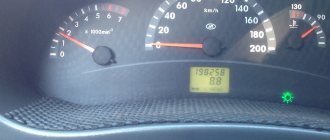The term troit engine VAZ 2109 means
The term “troit engine” appeared in the era of automotive development, when vehicle power plants were equipped with four-cylinder engines. If, for one reason or another, the working cylinder stopped functioning, then three cylinders remained in operation, which during operation made a characteristic sound, as if the engine was stalling in a damped mode.
Engine compression measurement for VAZ 2109
Subsequently, despite the complication of the design of the piston group and the increase in the number of cylinders, the term “troit engine” remained in use among car enthusiasts.
Brake booster failure
The vacuum brake booster (VUT) of the VAZ 2109 is not formally related to the operation of the cylinders. But failure of the VUT can lead to failure of the third cylinder. The engine will start to stall.
The vacuum booster is designed to reduce the force on the brake pedal required to effectively slow down the vehicle. To do this, VUT uses rarefied air, which it takes from the intake manifold. The intake hose fitting, equipped with a check valve, is located near the combustion chamber of the third cylinder. It is this cylinder that stops working if the amplifier fails or if the supply hose is damaged.
Due to the damage, atmospheric air is sucked in, the mixture becomes leaner, and ignition does not occur. Often, malfunctions in the operation of the brake pedal are accompanied by a significant increase in the force on the brake pedal; it becomes “dull” and does not provide proper deceleration. It happens that when you press the brake pedal, the engine stops revving and runs normally, but when you release the pedal, the third cylinder fails again. All of these are sure signs of a VUT malfunction, and they require your immediate response.
It is quite simple to make sure that the reason for the failure of the third cylinder lies in the amplifier.
If you have a spare amplifier, replacing the unit yourself is not difficult and can be done by yourself. If you go to the service, be careful: in fact, you are driving with faulty brakes.
Hello! Tell me, please, the car is a nine, it shakes wildly, especially when driving uphill, I’m zero in these matters, maybe I need to change the oil? I bought a car two years ago, I haven’t changed the oil yet, why is the engine running rough? (Basil)
Hello, Vasily. A motor can stall for many reasons, all of which are outlined below.
How to understand that the VAZ 2109 engine is troit?
The concept of “engine tripling” was invented by motorists themselves. It is associated with the design and operation of four-cylinder internal combustion engines. If one of the four cylinders failed, the internal combustion engine still continued to operate on the three remaining cylinders. But such a failure was distinguished by a characteristic sound, which was called “engine tripping” - functioning on only three cylinders. In this case, the fuel mixture in the idle cylinder will not burn as expected, but will accumulate.
If you do not respond to such a failure in the system in time, the fuel mixture will be diluted with oil, enter the crankcase with oil and dilute it thinner and thinner. In this case, the oil will lose its lubricating functions, which will lead to rapid wear of the rings, cylinder-piston group and other important parts of the car. A little later, the engine will have to be repaired not partially, but completely.
Similar failures occur in the VAZ-2109. They can be recognized by their characteristic features:
- The engine in idle mode manifests itself with periodic twitching, unevenly.
- When driving, the VAZ-2109 does not gain the required power.
- The car moves jerkily.
- If you press the gas pedal, failures in engine operation will be detected.
- An uneven exhaust comes out of the muffler, which is interrupted and accompanied by popping noises.
troit 99 injector
Auto 21099 injector 2003
The tachometer needle began to occasionally twitch at idle (jump by accident, although the engine runs smoothly), I drove without paying attention. But then I began to notice that when the needle jumped, the engine adjusted slightly.
The ignition module was old, the car twitched when I sharply pressed the gas pedal, I decided that the problem was in the module, I bought a new module, and at the same time replaced the spark plugs and explosive wires. To my delight, the problem disappeared, the car began to accelerate quickly without twitching, the idle was smooth, and the tachometer needle stopped twitching
Main reasons and their definition
When the engine in a VAZ 2109 stalls, the sound of the running engine acquires a characteristic timbre, where elements of vibration and rattling can be heard, and the engine power unit does not gain speed and operates unstable.
Breakdown of high-voltage wires of the VAZ 2109 is one of the reasons why the VAZ engine may start to fail
At the same time, the engine speed is unstable, its operation is not uniform, it makes sounds as if the engine is overcoming some invisible obstacle. The muffler emits intermittent exhaust with an uneven period of exhaust emission.
Causes of unstable engine idling
Most often, a situation arises when the engine stalls at idle speed. Moreover, it makes no difference whether this happens when it’s cold or when it’s hot. There can be many reasons for this, ranging from a simple spark plug failure to malfunctions in the piston group of the internal combustion engine. While it is very easy to replace a spark plug, wear on the cylinders in the block can lead to a major overhaul.
Most often, the engine does not operate stably at idle in the following cases:
- The valves are not adjusted (clamped);
- The timing belt is installed incorrectly (the marks do not match);
- The IAC is faulty;
- The cylinder head valves are bent or burnt out (the valves can bend during a water hammer when a large amount of water gets into the air filter housing);
- The piston burned out;
- There is a malfunction in the electronic engine control system. The sensors, the ECU itself, electrical wiring and I/O wires may be to blame here.
There are many options for why the car idles at idle, but there are still the most basic ways to determine faults.
Reasons why an unheated VAZ 2109 engine fails
Soot on the spark plugs of the VAZ 2109 indicates the presence of a poor fuel-air mixture (another reason why the VAZ 2109 engine stalls). It
often happens that the VAZ 2109 stalls when cold, and as it warms up, the engine levels out and begins to work stably. There could be several reasons:
- The ECU sets the fuel mixture too rich to cold;
- The spark plug does not work, but when heated, the spark plug still “breaks through”;
- The high-voltage wires are damp or moisture has entered the ignition coil;
- Parts of the piston group are worn out.
Video: Why the engine on the VAZ 2109 is tripping
Valves and piston
These systems are tested together. First you need to remove the breather hose from the manifold. If white smoke comes from it, then the cause of the cylinder failure is definitely the piston. You should disassemble the engine and see what happened.
Most often, the rings are stuck; to eliminate them, you will have to remove the pistons. If there is no smoke, or it is almost colorless, then the problem is in the valves. First, let's measure the compression. If it is less than 11, then the diagnosis is a burnt valve. You will have to remove the head, change the valve and grind it in. If everything is fine with compression, remove the engine cover and check the valve adjustment. The engine can fail either because the valve is tight or because it is too loose. In any case, they need to be adjusted.
What to do and what to pay attention to
In order to determine why the engine in a VAZ 2114 is misfiring, you must follow the recommendations of professionals. First of all, you need to determine which cylinder is out of order, for this you need to:
- open the hood with the engine running;
- remember the sound and nature of the operation of the power plant;
- remove the high-voltage wires from the spark plugs one by one, if the sound and rhythm of operation changes, then continue further, as soon as it is discovered that when the spark plug is de-energized, the nature of the sound does not change, which means the faulty cylinder has been identified.
Next, you need to unscrew the spark plug and determine its condition and performance.
It is unscrewed using a special spark plug wrench, which is recommended to be carried with you in an emergency kit. It takes up little space, but is a unique key that cannot be replaced and can come in handy at the most unexpected time. After all, even simply by replacing a heavily carbonated spark plug with a new one, you can temporarily solve the problem with starting the engine.
The next step is to determine the condition of the removed spark plug. If the electrode is intact and clean, and there is a large amount of soot on the head, then with a high degree of probability it can be determined that dust has entered the combustion chamber of the cylinder, therefore the fault must be looked for in the air supply system through the air filter.
If the entire head, along with the electrode, is covered in smoke, and it is severely burnt out, it means that a lean mixture was supplied and detonation combustion occurred with ignition advance. When the head is also completely covered with smoke and the electrode is in good condition, this means that a rich mixture was supplied and there was a delay in the ignition supply.
Ignition coil module VAZ 2109
Assessing the condition of the spark plug gives direction in finding the true cause of cylinder failure. However, you should also check the performance of the candle itself. There is a proven method for this - “by spark”. If a spark breaks through, even if weak due to carbon deposits, then you must definitely look further. But if there is no spark at all, then you should replace the spark plug with a new one and check it. If there is a good spark, you can try to start the car and monitor the dynamics of changes.
If the car has a fairly high mileage, then trying to find the reason why the engine is shaking, you must do the following:
- change the spark plug;
- change the set of high-voltage wires; during prolonged operation under conditions of high temperatures and voltages, microcracks appear on the shell, leading to breakdowns and failure; experienced auto electricians recommend periodically changing this set for prevention;
- measure the compression in the idle cylinder; if it is broken, then perhaps the rings are stuck or the valves are burnt out;
- adjust the valves, this procedure should be carried out for prevention every 15 - 20 thousand kilometers;
- determine the performance of the ignition coil, this is a fairly common failure, the best solution is to replace the old one with a new one;
- change the air filter;
- Check that the timing belt is installed correctly.
All the specified procedures have been completed, but the engine still “troubles”. We need to move on:
- Conduct diagnostics of the electronic control unit and replace if necessary.
- Check the fuel supply system, down to the injectors.
- Determine the performance of the oxygen sensor, if it is faulty or produces deteriorated indicators - repair or replace.
- The failure of the crankshaft position sensor is determined by the computer, and an error should be generated indicating a breakdown. If this happens, replace it.
Solution methods
Once the main reasons why the VAZ 2109 engine fails are identified, you can proceed directly to methods of diagnosing and troubleshooting problems. It is worth recalling that for a complete diagnosis you will need certain tools, as well as design knowledge of the power unit.
We remind you that the VAZ 2109 injector engine has eight valves marked 2111-80.
So, what tools will you need: a set of keys, heads and screwdrivers, a hammer, WD-40, a multimeter, as well as new spare parts that have become unusable. Now that everything is at hand, you can proceed directly to the repair process.
Poor quality fuel
The engine often jerks and tripping occurs because low-quality fuel enters the combustion chambers. This is typical for the CIS countries, especially Russia and Ukraine, since most gas stations dilute gasoline or sell it of low quality.
So, low-quality fuel, in addition to clogging the fuel lines, also, when it gets into the combustion chambers, does not form a normal air-fuel mixture, and therefore the car begins to twitch and jerk, in the worst case, black smoke and shots will come from the exhaust pipe. This means that the gasoline is not the best and should be replaced.
To eliminate the malfunction at this stage, you will have to clean the fuel supply elements, such as the fuel tank, gas lines, injectors and the fuel filter element (which is most likely clogged).
Fuel pump and gasoline filter element
Even if the fuel that enters the engine and its systems is of fairly good quality, you do not need to be sure that the fuel supply elements will not fail. The second reason why a car starts to run poorly is a faulty fuel pump. To be more precise, interruptions in the operation of such an important element lead to an uneven supply of fuel to the engine.
Therefore, it is recommended to check the fuel pump for functionality and serviceability. If necessary, carry out repair operations or replace the element.
Every 30,000 km the fuel filter must be replaced. But, as practice shows, the quality of fuel forces motorists to do this much more often. So, when overhauling the fuel pump, it is recommended to replace the fuel filter, which costs a penny.
Injectors
Another important element that affects the formation of the air-fuel mixture is the injector. Thus, they can fill the spark plugs when the output is high or give a lean mixture when they are clogged. So, during operation they become clogged or fail.
To eliminate the cause, it is necessary to dismantle the elements from the power unit, and then carry out diagnostic operations on a special stand. If diagnostics show that one or more elements are faulty, they must be urgently replaced. The remaining injectors are cleaned and installed back into the power unit.
Spark plugs and high voltage wires
Malfunctions of the spark generation system can also lead to the effect of tripping and jerking. So, the motorist needs to unscrew the elements from the cylinder head and inspect them. If you find that one of the spark plugs is damaged, then the element must be replaced.
It is worth noting that it is recommended to replace all four spark plugs, having previously adjusted their gaps.
As for high-voltage wires, it is necessary to dismantle the elements, as well as carry out diagnostic operations using a multimeter. The resistance in each wire should be about 5 ohms.
Valves burnout
The saddest option for a car enthusiast is a burnout of the valve mechanism. It is worth noting that the VAZ 2109 engine has 8 valves: 4 intake and 4 exhaust. This malfunction leads to several consequences at once.
Firstly, you will have to carry out a major overhaul of the cylinder head, which will not only hit your wallet, but will also take a lot of time. Secondly, most likely, if the valve mechanism is burned out, then there is a problem in the piston mechanism.
Therefore, if it is discovered that the valves and valve seats are out of order, then you should prepare for the fact that it is necessary to carry out a complete overhaul of the engine.
Air filter and throttle
The formation of the air-fuel mixture is also affected by the condition of the air filter element and the throttle valve. According to the technical documentation and manuals of the manufacturer, the air filter is changed every 20,000 km or twice a year: in spring and autumn.
If the throttle valve is clogged, it can be cleaned using carburetor cleaning fluid. It is also recommended to look at the condition of not only the throttle, but also the air corrugation that supplies oxygen.
Sensors and ECU
On VAZ 2109 engines, an electronic control unit January 5.1 was installed to control engine operation. Thus, accumulated errors or a malfunction of the element itself can lead to disruption of the motor. Therefore, it is worth connecting to the part and finding out what state the software is in.
It is also recommended to review the performance of sensors responsible for the normal operation of the power unit, such as the idle speed controller, coolant temperature sensor, throttle position sensor and others. Diagnostics of the elements can be carried out using a multimeter.
Checking the engine at idle
Faulty VAZ 2109 ECU (burnt-out transistor unit)
If you notice that the VAZ-2109 engine starts to oscillate at idle, then you need to check the following systems:
- Fuel supply system.
- Ignition system.
- Valve system.
In the first case, if the faults are in the fuel supply system, then the first step is to flush the fuel system, and then clean the injectors using ultrasound.
The second case involves problems with the ignition system. Therefore, perform the following actions:
- change spark plugs;
- check the functionality of the ignition coil;
- update the set of high-voltage wires.
In the third case, the valves are closely dealt with, that is, they should be adjusted so that they perform their functions properly. If this cannot be done, the old valves are simply replaced with new ones.
Reason one - spark plugs
I wrote in detail about how to determine faults in car systems using spark plugs
here .
I recommend reading it - it turned out to be useful, judging by your reviews, thank you.
We unscrew the spark plugs one at a time and look at their insulator.
If it is covered with dense carbon deposits, then it is difficult for a spark to penetrate it. The current seeks the path with the least resistance, so the spark will not be between the electrodes, but will “go” along the insulator to the side. Its energy will not be enough to set fire to the air-fuel mixture. This cylinder will not work.
We inspect the external condition of the spark plug insulator.
If there are microcracks, then part of the current will not be converted into a discharge, but will escape through these damages. You need to look at the internal insulator, which is screwed into the cylinder head, and at the external one, onto which the armor wire cap is placed.
Any chips or damage can lead to poor sparking or its complete absence.
Large or small gap between electrodes.
Many people have heard or know that for certain engines, ignition systems and types of fuel used, spark plugs with a certain gap are required. Usually its value is indicated by the manufacturer of engines and cars.
How to check the spark without special devices on the engine
This is an old, “grandfather” method, some people are afraid of it:
- They unscrewed the spark plug;
- They put an armored wire on her;
- They leaned it with the inner body, the metal part, against the engine;
- Turn on the ignition and turn the starter.
Be sure to hold on to the rubber cap of the armored wire, otherwise your hand will shake violently. This is what many are afraid of
We look at the spark when trying to start the engine. If it hits clearly between the electrodes, is bright, and does not move to the side, then the candle is “live”. Screw it into place. Let's move on to another “subject”.
What to do with black carbon
First of all, let's look at the cause of the rich mixture. It is this that is the source of this deposit on the electrodes. Perhaps it appeared as a result of the “dying” of the spark plug, when the fuel stopped igniting normally. This soot was deposited on the electrodes and insulator.
We try to clean the spark plug with sandpaper. We only clean the electrodes themselves; there is no need to touch the insulator. We install it in place, start it and listen to the engine.
This will help, but it is not a panacea; you need to look for the cause of the formation of soot.
What to do with a large or small gap
Many Zhiguli owners know how to adjust it themselves. To do this, you will need a set of probes of different thicknesses, a hammer or pliers.
- Let's find out what interelectrode gap is recommended for your engine. For example, on Zhiguli cars with a contactless ignition system, 0.7-0.8 mm is recommended;
- We take the probes, find the appropriate size and put them between the electrodes of the spark plug;
- If it climbs freely, gently tap the side electrode with a hammer (not a sledgehammer) or pliers. Sometimes it’s enough to press hard and the electrode will give way. We measure again, if it flies by again with a whistle, we bend it again;
- If it doesn’t fit through, bend it over the edge of the side electrode with pliers. It is advisable to do this with a thin screwdriver. We insert it between the electrodes and bend the central one a little.
You don’t have to “have” a brain for yourself, but buy spark plugs in the store recommended by the car or engine manufacturer.
